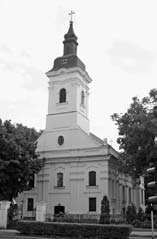The Orthodox church municipality in Subotica on January 5, 1787 prays Magistrat to allow more of its fellow countrymen, delivering a list of the names of 80 Serbs, who expressed their desire to move from the city to Alexandrovo, in whose territory the colonization has begun. The Serbs wanted to establish their permanent domicile here, and their desire for colonization stems from the fact that the proclamation of Subotica for a free royal city was brought into the position of citizens of the second order, without the right to obtain citizenship and the disposal of real estate in the city. In February 1804, Shandor, as it was called Alexandrovo until 1918, was officially proclaimed village, and the majority of the population was Serbs, who are still cited as “graci non uniti” and a small number of Bunjevci, “romano catholici”.
By 1811, the Serbs confirmed their desire to raise the sanctum by establishing the Fund for Raising Orthodox Church in the village. By 1815, the Fund accumulated so much resources that it began to procure construction material, and we assume that the construction of the church was completed until the phase of maintaining the service in 1818.
According to its architectural outlook, the church in Alexandrov belongs to a group of Orthodox temples built in the 1930s and 1940s in Backa, made according to a typical project, built in the style of Baroque, with purified and dated decoration indicating the classicistic patterns. The church is basically single-breasted, with a semicircular apse in the east and with accentuated rectangular singing outs, which in the interior have a semicircular shape. It draws out the lines from the naosity line, and the facade carries a slightly more pronounced decoration, which mostly comes down to a strictly straight plastic, cut around the orifices and pilasters. The central place on the facade occupies a niche with a painted representation of the patron of the church of St. Dimitrija Velikomučenika. The tombs were built in the tombstones of the church’s patrons and famous Serbs, and in the port, on the west side, to the left of the entrance was laid in 1852.the stone cross which Prokopija Rzic and Kiril Aradski raised.
When the interior of the church is decorated, who painted the original iconostasis and where it ended, remains unknown to this day.
The special value of the temple today is the iconostasis which, during the great renovation of the Vaznesenjska church in the city, by the decision of the Church Committee from 15/28. June no. CO141 / 1909. paid to this small Baroque church.
Only after his first clean-up, performed by Dušan Nonin (1924-2004) by the painter conservator of the Provincial Institute for the Protection of Cultural Monuments, Novi Sad, and especially after the publication of the work entitled “Cleaning the iconostasis in Aleksandrov near Subotica”, he will come to a series controversy about the attribution of this painter’s ensemble. An example of a remarkable painting achievement that suppressed the long zoographic tradition and the beginning of new art in the Serbs, a theme that is occupied by art historians, and which have not yet harmonized their unique opinion about the mysterious author of this iconostasis. Miodrag Kolaric, who first studied painting on the iconostasis, told an anonymous author: “The master from Aleksandrov goes far beyond his contemporaries. In spite of a certain discipline of heritage, he was bold, safe and inspired …While his predecessors, despite his undeniable gift, are predominantly decorative, he is mostly pictorial … He extracts the dyed values of basic tones, what we now call valerian painting. ” At the moment, it seems to him that the similarity of the manuscript is “closest to Dimitri Bacevic”, which immediately denies it by claiming that it exceeds the knowledge and the sense of style and the ability to express it in a purely painting manner.
One of these extremely valuable painting achievements was attributed to Teodor Ilić Česljar, but in one of them all researchers agree, which is the fact that the master of this iconostasis acquired his painting skills in a workshop under the influence of a good Western European iconographic source. In his research work, Dinko Davidov relies on already known and researched facts that our painters accepted Baroque painting as one of the roundabouts that led through Ukraine and Kiev’s lavra. He’s his first discoveries and the possibilities of discovering the author of this iconostasis, is based on the findings after the research of Serbian painting in Hungary. Namely, in Szeged, a city that is very near Subotica, in the Treaty of Painting the Iconostasis of the Nikolajevska Church, it is stated among other things: “The lady in Segway, June 7th, 1761.Soveršitel sego djela djela Jovan Popović “.
After the iconostasis was transmitted to the Aleksandrovac church, it was found that the iconostasis was higher than the church vault, and on that occasion it was grossly damaged, with the icons of the apostles Peter and Paul cut in half. The upper painted parts with medallions, inscribed in 1766, are now in the Gallery of Matica Srpska in Novi Sad.
The icons were made using a wood-based oil technique, with the exception of four icons in the squid that were painted on the canvas. Duborez was made in Baroque style with scarlet elements. It was made using a patterned pattern with frequent repetition of the motif, and the golden-colored optic connects all the icons into one whole, giving it some stabilization. The richest carving has imperial doors, while the side doors with the upper semicircular finish have no bumps.
The icons on the Virgin and the Archbishop’s Throne are of a recent date, and they were painted by Stefan Stefanovic from Sremski Karlovci in 1923. These are copies of Predic’s solutions. At the Arch of Throne there is the icon of St. Sava.
SERBIAN ORTHODOX CHURCH OF ST. DEMETRIUS


0 comments on “SERBIAN ORTHODOX CHURCH OF ST. DEMETRIUS”